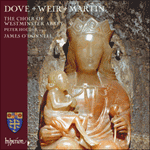
Welcome to Hyperion Records, a British classical label devoted to presenting high-quality recordings of music of all styles and from all periods from the twelfth century to the twenty-first.
Hyperion offers both CDs, and downloads in a number of formats. The site is also available in several languages.
Please use the dropdown buttons to set your preferred options, or use the checkbox to accept the defaults.

| Westminster Abbey Choir, James O'Donnell (conductor), Peter Holder (organ)» More |
from notes by Jeremy Dibble © 2022
Le Kyrie déroge un peu aux habitudes de Dove avec une plus grande linéarité, davantage de polyphonie et un développement plus important, atteignant un apogée vers la fin. La partie d’orgue est minimale et recourt au procédé des accords tenus pour lier les courtes phrases vocales. Les impressionnants accords en cluster et leur formation rappellent l’écriture organistique de Kenneth Leighton. Le Gloria est un genre de moto perpetuo, l’orgue installant une figure rythmiquement dansante dans les premières mesures. Le chœur chante des phrases brèves, dans différentes dynamiques, qui ne lâchent pas la ferveur rythmique jusqu’à ce que les mots «Agnus Dei, Filius Patris. Qui tollis peccata mundi, miserere nobis» autorisent un relâchement de la tension, encore que l’orgue, en dessous, maintienne l’élan. Un spectaculaire apogée est atteint à «Jesu Christe» (aux mots «Tu solus altissimus, Jesu Christe»), quand Dove envoie brillamment la musique en ré bémol majeur, à partir d’une tonalité en la majeur, après quoi le mouvement danse jusqu’à une conclusion étincelante. Le Sanctus & Benedictus poursuit la danse dans une sémillante musique à 5/8. La manière dont les accords d’orgue se construisent avant l’entrée chorale n’est pas sans rappeler la Missa brevis de Britten. Toutefois, là où ce dernier débouche droit sur une écriture carillonnante, Dove part sur une explosion en accords au mot «Sanctus», réservant son écriture chorale carillonnante au «Dominus Deus Sabaoth». L’Hosanna, à la fin, ramène les accords liminaires du mouvement. L’Agnus Dei est formé par-dessus une pédale d’orgue, avec un mi grave tenu et un la, qui bouge seulement deux fois au cours du mouvement, provoquant, avec presque rien et pour un effet maximal, une irréversible augmentation de la tension. Passé six mesures d’introduction à l’orgue (une courte figure jouée par la main droite nous prépare à l’entrée chorale), le chœur chante de brèves phrases en accords. Le matériau organistique liminaire est réduit à quatre mesures pour l’entrée chorale suivante et le premier déplacement de la pédale. Puis le matériau de l’orgue est encore réduit à deux mesures et la pédale paroxystique passe d’ut à sol, avec le chœur qui chante vigoureusement l’«Agnus Dei» avant de s’effacer dans une répétition, façon mantra, des mots «dona nobis pacem». Un mouvement vraiment splendide et impressionnant.
extrait des notes rédigées par Paul Spicer © 2010
Français: Hypérion
Im Kyrie weicht Dove deutlich von seinem üblichen Stil ab. Die Entwicklung ist linearer, stärker polyphonisch und steigert sich gegen Ende zu einem Höhepunkt. Der Beitrag der Orgel ist auf ein Minimum beschränkt und verbindet die kurzen Textteile durch ausgehaltene Akkorde. Die wirkungsvollen Cluster-Akkorde und ihre Anordnung erinnern an den Orgelkompositionsstil von Kenneth Leighton. Das Gloria ist eine Art moto perpetuo, in dem die Orgel mit den einleitenden Takten eine rhythmisch tanzende Figur einführt. Der Chor singt kurze Phrasierungen mit unterschiedlicher Dynamik, die sich von der rhythmischen Erregung erst mit den Worten „Agnus Dei, Filius Patris. Qui tollis peccata mundi, miserere nobis“ lösen und die Spannung lockern, wenngleich die Orgel darunter die fortlaufende Bewegung aufrecht erhält. Mit den Worten „Tu solus altissimus, Jesu Christe“ wird ein spektakulärer Höhepunkt erreicht, wo Dove die Musik aus der A-Dur-Tonalität nach Des-Dur springen und den Satz zu einem brillanten Ende tanzen lässt. Das Sanctus und Benedictus setzt den Tanz in „spritzigem“ Fünfachteltakt fort. Hier werden die Orgelakkorde ähnlich wie in Brittens Missa brevis vor dem Einsatz des Chors aufgebaut, doch im Unterschied zu Britten, der unmittelbar zu glockenähnlichem Klang übergeht, beginnt Dove mit einem Akkordausbruch auf dem Wort „Sanctus“ und behält sich den Glockenklang für die Worte „Dominus Deus Sabaoth“ vor. Das abschließende Hosanna bringt die einleitenden Akkorde des Satzes zurück. Das Agnus Dei ist auf einem Orgelpunkt mit ausgehaltenem tiefem E und A aufgebaut, der sich während des ganzen Satzes nur zweimal bewegt und auf diese Weise die Spannung geschickt mit geringstem Aufwand und größtmöglicher Wirkung steigert. Nach einer sechs Takte langen Orgeleinleitung (eine kurze Figur in der rechten Hand bereitet den Einsatz des Chors vor) singt der Chor kurze Akkordphrasierungen. Das Orgelmaterial der Einleitung wird in Vorbereitung auf den nächsten Choreinsatz und auf die erste Orgelpunktbewegung auf vier Takte und dann noch einmal auf zwei Takte verkürzt, und der zum Höhepunkt strebende Orgelpunkt verschiebt sich nach C und G, während der Chor kräftig das abschließende „Agnus Dei“ singt, um dann mit einer gebetsformelähnlichen Wiederholung der Worte „dona nobis pacem“ zu verklingen, ein sehr schöner und wirkungsvoller Satz.
aus dem Begleittext von Paul Spicer © 2010
Deutsch: Henning Weber
 Dove, Weir & Martin (M): Choral works Dove, Weir & Martin (M): Choral worksA diverse selection of works by three of today’s composers who demonstrate a particular affinity for choral music.» More |

